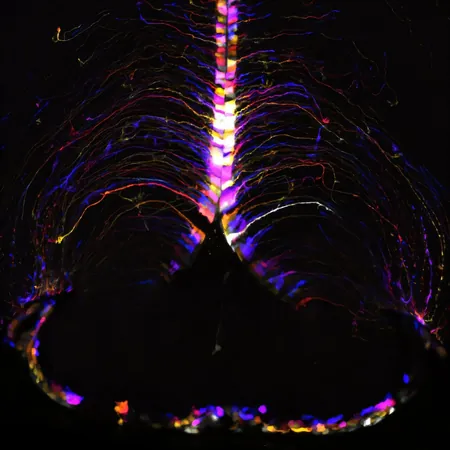
Revolutionary Research Uncovers Key Players in Brain Aging: Are We Closer to Anti-Aging Therapies?
2025-01-01
Author: John Tan
Revolutionary Research Uncovers Key Players in Brain Aging: Are We Closer to Anti-Aging Therapies?
Groundbreaking research from the esteemed Allen Institute has shed light on the complex changes that occur in the brain as it ages. The findings, published in the renowned journal *Nature*, identify specific cell types in the brains of mice that undergo significant transformations over time, marking a crucial step toward potential therapies aimed at slowing down or managing the aging process.
The scientists focused on glial cells—often referred to as brain support cells—that exhibited substantial shifts in gene expression as the mice aged from two months to 18 months, the latter equivalent to late middle age in humans. Among the most affected cell types were microglia, which are vital for brain immunity and maintenance, as well as various other support cells like oligodendrocytes and ependymal cells.
Remarkably, the study revealed a “hot spot” in the hypothalamus where these age-related changes converge. Specifically, genes associated with inflammation showed increased activity, while those linked to neuronal structure and function experienced a decline. This area, particularly around the third ventricle of the hypothalamus, encompasses cell types that play critical roles in regulating food intake, energy balance, and metabolism.
Lead author Kelly Jin, Ph.D., emphasized the significance of these findings, suggesting that the identified cell types might be losing their efficiency in responding to environmental signals and dietary intake. “This loss of efficiency could be a fundamental contributor to what we perceive as aging throughout the body—an exciting realization,” she stated.
Utilizing advanced techniques such as single-cell RNA sequencing and innovative brain-mapping tools developed through the NIH's BRAIN Initiative, researchers meticulously analyzed over 1.2 million brain cells across 16 key regions, highlighting the intricate similarities between mouse and human brain structures, functions, and genetic profiles.
As Dr. Richard J. Hodes, director of the NIH’s National Institute on Aging, noted, aging is the primary risk factor for Alzheimer’s disease and numerous other debilitating brain disorders. This new, detailed cellular map could fundamentally reshape scientific understanding regarding aging in the brain and provide a roadmap for developing targeted treatments for age-related illnesses.
A Path Toward Groundbreaking Therapies
The implications of this “hot spot” discovery are profound. It opens a new chapter for research targeted at improving cell function, potentially delaying aging processes and preventing neurodegenerative diseases. “Our goal is to develop specialized tools aimed at these specific cell types,” commented Hongkui Zeng, Ph.D., executive vice president of the Allen Institute. “By enhancing these cell functions, we may be able to halt or even reverse elements of the aging process.”
The research parallels previous studies linking aging to metabolic changes and suggests that dietary practices such as intermittent fasting, balanced nutrition, or calorie restriction could positively affect lifespan. While the current study did not directly test these dietary links, the findings highlight the relevance of diet in the aging process.
“Identifying these unique populations of neurons that express specific genes offers the potential for targeted interventions,” Jin explained, hinting at exciting future explorations.
Looking Ahead: The Future of Brain Aging Studies
This study not only sets the stage for innovative dietary strategies and therapeutic options aimed at preserving brain health in later years but also calls for deeper investigations into the complexities of aging behavior in the human brain. As research progresses, it may unveil more precise dietary recommendations or pharmacological strategies to combat or reduce cellular aging effects.
As Zeng concluded, “Our study has revealed the crucial players and their biological roles in the aging process. It's vital to focus on cell type-specific changes as these subtle shifts could go unnoticed if we were to look at the brain as a whole.”
Now more than ever, we stand on the brink of a potential breakthrough in how we approach brain health and aging—could this be the dawn of a new era in the fight against neurodegenerative diseases?

 Brasil (PT)
Brasil (PT)
 Canada (EN)
Canada (EN)
 Chile (ES)
Chile (ES)
 Česko (CS)
Česko (CS)
 대한민국 (KO)
대한민국 (KO)
 España (ES)
España (ES)
 France (FR)
France (FR)
 Hong Kong (EN)
Hong Kong (EN)
 Italia (IT)
Italia (IT)
 日本 (JA)
日本 (JA)
 Magyarország (HU)
Magyarország (HU)
 Norge (NO)
Norge (NO)
 Polska (PL)
Polska (PL)
 Schweiz (DE)
Schweiz (DE)
 Singapore (EN)
Singapore (EN)
 Sverige (SV)
Sverige (SV)
 Suomi (FI)
Suomi (FI)
 Türkiye (TR)
Türkiye (TR)
 الإمارات العربية المتحدة (AR)
الإمارات العربية المتحدة (AR)